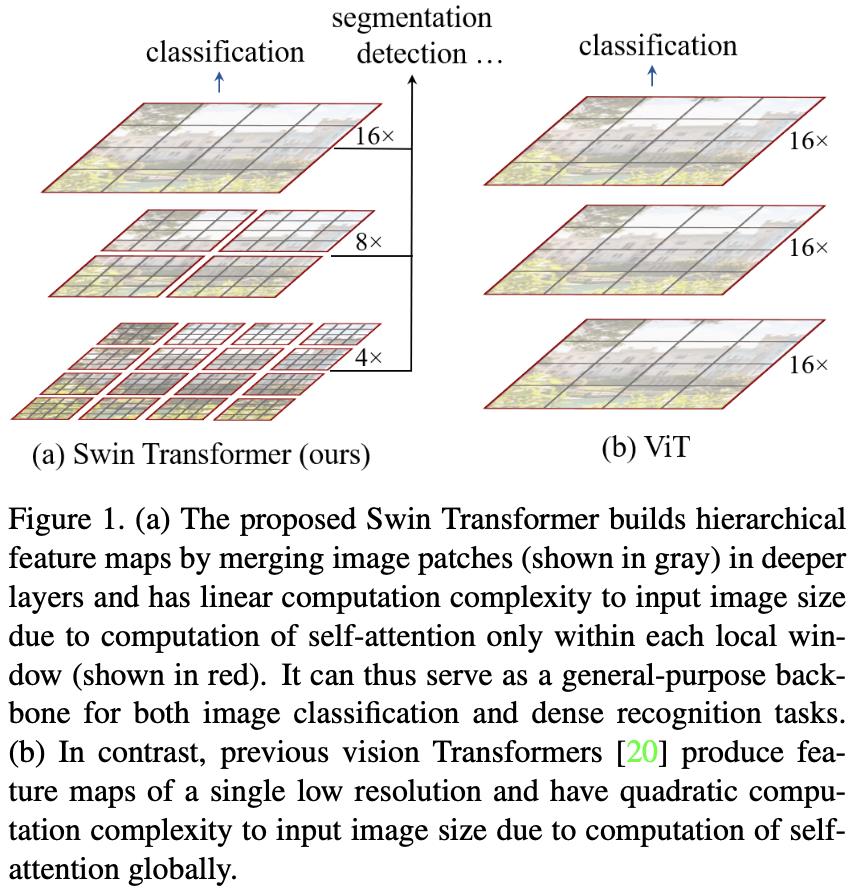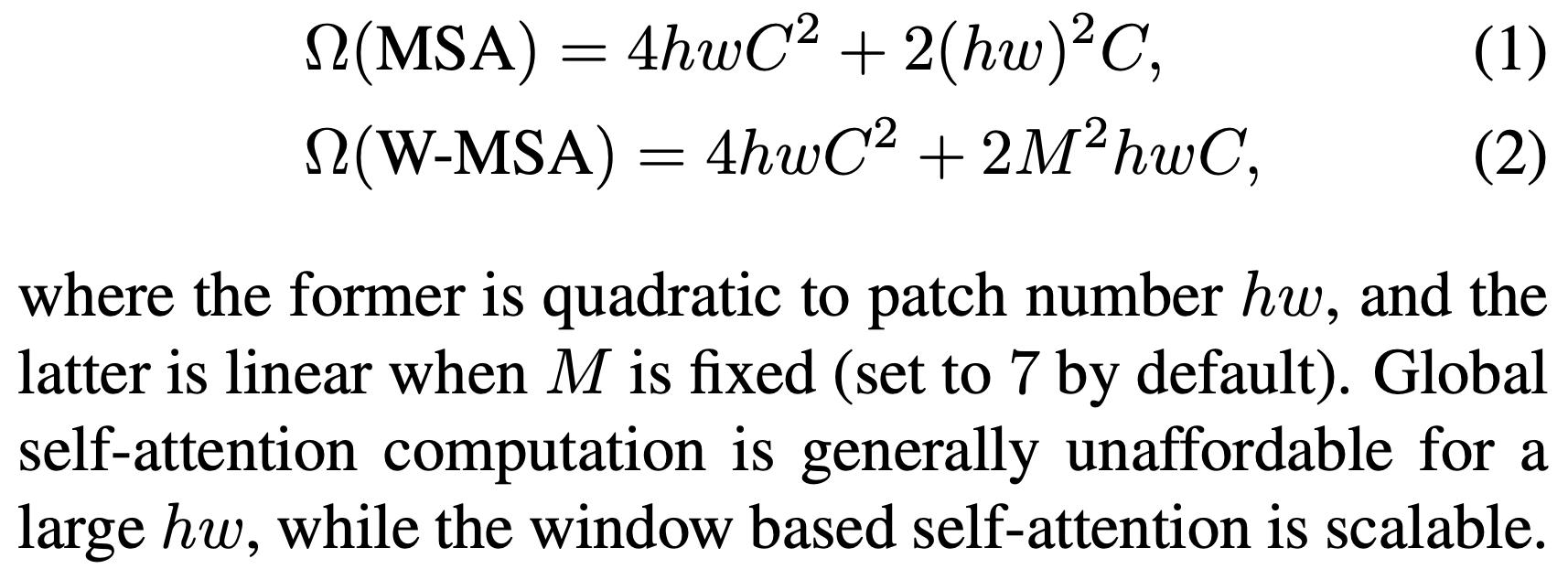PyTorch笔记 - SwinTransformer的原理与实现
Posted SpikeKing
tags:
篇首语:本文由小常识网(cha138.com)小编为大家整理,主要介绍了PyTorch笔记 - SwinTransformer的原理与实现相关的知识,希望对你有一定的参考价值。
Swin Transformer: Hierarchical Vision Transformer using Shifted Windows
MRA:Microsoft Research Asia,微软亚洲研究院
参考:Swin Transformer 相比之前的 ViT 模型,做出了哪些改进?
时间复杂度降低:
- MSA(Multi-head Self-Attention):
4*H*W*C^2 + 2*(H*W)^2*C - WMSA(Window Multi-head Self-Attention):
4*H*W*C^2 + 2*M^2*(H*W)*C - HW的平方复杂度,降低为线性复杂度


SwinTransformer:
- Patch Embedding
- naive method
- conv2 method
- SwinTransformer Block
- Window Multi-Head Self-Attention
- Shift Window Multi-Head Self-Attention:shift window、window mask、reverse shift window
- Patch Merging
- Patch reduction (降低)
- Depth expansion (扩展)
- Classification
2021年8月发表:
SwinTransformer:将复杂度和效果,都做了优化,Transformer在NLP中取得比较好的效果。
将图像划分为不同的window,每个window内计算self-attention,时间复杂度window与图像的hw成线性关系,通过shift-window,实现window之间的交互。

To address these differences, we propose a hierarchical Transformer whose representation is computed with Shifted windows.
- 为了解决这些差异,我们提出了一种分层 Transformer,其表示是用 Shifted windows (Swin)计算的。
This hierarchical architecture has the flexibility to model at various scales and has linear computational complexity with respect to image size.
- SwinTransformer这种分层架构,具有在各种尺度上建模的灵活性,并且,具有相对于图像尺寸的线性计算复杂度。

步骤:
- 将RGB图,切分为互相不交叠(non-overlapping)的区域(patch),类似ViT;
- 每个patch有4x4,通道是3,特征维度4x4x3=48个像素,48个像素通过MLP,映射是线性模式;
- 通过Patch Merging层,特征图减少4倍,通道数增加2倍(MLP 4->2),把2x2的patch合并成1个patch;
- 每2个Block,1个是W-MSA和SW-MSA,每个window内计算Self-Attention;
- SW-MSA是移动1/2个窗长,再做合并做Self-Attention。

每个Patch是4x4x3=48个像素大小,把像素值组成向量,经过一个线性层(MLP Multilayer Perceptron,多层感知机,Linear Embedding Layer),转换为C维的向量,作为Embedding。Swin-Transformer Block 应用于Embedding之上。
时间复杂度:

1. 如何基于图像生成Patch Embedding
方法一:
- 基于PyTorch Unfold的API来将图像进行分块,也就是模仿卷积的思路,设置
kernel_size=stride=patch_size,得到分块后的图片。 - 得到格式为
[bs, num_patch, patch_depth]的张量。 - 将张量与形状为
[patch_depth, model_dim_C]的权重矩阵进行乘法操作,即可得到形状为[bs, num_patch, model_dim_C]的patch embedding。
F.unfold:输入为(N, C, H, W),其中N为batch_size,C是channel个数,H和W分别是channel的长宽,K1xK2是kernel_size。unfold输出为(N, C×(K1xK2), L),L是根据kernel_size滑动剪裁之后得到的区块数量,参考卷积计算公式 M = (N+2P-K)/S + 1。
方法二:
patch_depth是等于input_channel * patch_size * patch_sizemodel_dim_C相当于二维卷积的输出通道数目- 将形状为
[patch_depth, model_dim_C]的权重矩阵转换为[model_dim_C, input_channel, patch_size, patch_size]的卷积核。 - 调用PyTorch的conv2d API得到卷积的输出张量,形状为
[bs, output_channel, height, width],output_channel和input_channel一致。 - 转换为
[bs, num_patch, model_dim_C]的格式,即为patch embedding
源码:
import torch
import torch.nn as nn
import torch.nn.functional as F
import math
# 难点1 patch embedding
def image2emb_naive(image, patch_size, weight):
"""
直观方法去实现patch embedding
"""
# patch = [bs, num_patch, patch_depth]
patch = F.unfold(image, kernel_size=(patch_size, patch_size), stride=(patch_size, patch_size)).transpose(-1, -2)
# weight = [patch_depth, model_dim_C]
# patch @ weight = [bs, num_patch, model_dim_C]
patch_embedding = patch @ weight
return patch_embedding
def image2emb_conv(image, kernel, stride):
"""
基于二维卷积来实现patch embedding,embedding的维度就是卷积的输出通道数
"""
conv_output = F.conv2d(image, kernel, stride=stride) # bs*oc*oh*ow
bs, oc, oh, ow = conv_output.shape # model_dim_C就是oc
patch_embedding = conv_output.reshape((bs, oc, oh*ow)).transpose(-1, -2)
return patch_embedding
2. 如何构建MHSA(MultiHead Self-Attention)并计算其复杂度?
矩阵计算复杂度:[AxB] x [BxC] = 复杂度ABC
- 基于输入x进行3个映射分别得到qkv
- 此步复杂度为
3 * L * C^2,其中L位序列长度,C为特征大小 - 每个特征都线性映射1次,复杂度是
[LxC] x [CxC] = L * C^2
- 此步复杂度为
- 将qkv拆分成多头的形式,注意这里的多头各自计算不影响,所以可以与bs维度进行统一看待
- 计算
q * k_t,并考虑可能的掩码,即让无效的两两位置之间的能量为负无穷,掩码是在shift window MHSA中会需要,而在window MHSA中暂不需要- 此步复杂度是
L^2 * C,复杂度是:[LxC] x [CxL] = C * L^2,
- 此步复杂度是
- 计算概率值与v的乘积
- 此步复杂度是
L^2 * C,复杂度是:[LxL] x [LxC] = C * L^2
- 此步复杂度是
- 对输出进行再次映射
- 此步复杂度是
L * C^2,复杂度是[LxC] x [CxC] = L * C^2
- 此步复杂度是
- 总体复杂度为
4*L*C^2 + 2*L^2*C
torch.chunk:切分,将tensor切分为多个块,维度保持不变。
源码如下:
# MSA or MHSA
# 复杂度:
class MultiHeadSelfAttention(nn.Module):
def __init__(self, model_dim, num_head):
super(MultiHeadSelfAttention, self).__init__()
self.num_head = num_head
self.proj_linear_layer = nn.Linear(model_dim, 3*model_dim)
self.final_linear_layer = nn.Linear(model_dim, model_dim)
def forward(self, input, additive_mask=None):
bs, seqlen, model_dim = input.shape
num_head = self.num_head
head_dim = model_dim // num_head
proj_output = self.proj_linear_layer(input) # 映射为3个model_dim,[bs, seqlen, 3*model_dim]
q, k, v = proj_output.chunk(3, dim=-1) # 3 * [bs, seqlen, model_dim]
# [bs, seqlen, num_head, head_dim]
q = q.reshape(bs, seqlen, num_head, head_dim).transpose(1, 2) # model_dim -> num_head, head_dim
q = q.reshape(bs*num_head, seqlen, head_dim) # 相当于bs提升, num_head不参与计算
k = k.reshape(bs, seqlen, num_head, head_dim).transpose(1, 2) # model_dim -> num_head, head_dim
k = k.reshape(bs*num_head, seqlen, head_dim) # 相当于bs提升
v = v.reshape(bs, seqlen, num_head, head_dim).transpose(1, 2) # model_dim -> num_head, head_dim
v = v.reshape(bs*num_head, seqlen, head_dim) # 相当于bs提升
if additive_mask is None:
# k的转置是转的最后2维
attn_prob = F.softmax(torch.bmm(q, k.transpose(-2, -1)) / math.sqrt(head_dim), dim=-1)
else:
additive_mask = additive_mask.tile((num_head, 1, 1)) # 扩充至num_head倍
attn_prob = F.softmax(torch.bmm(q, k.transpose(-2, -1)) / math.sqrt(head_dim) + additive_mask, dim=-1)
output = torch.bmm(attn_prob, v)
output = output.reshape(bs, num_head, seqlen, head_dim).transpose(1, 2) # [bs, num_head, seqlen, head_dim]
output = output.reshape(bs, seqlen, model_dim)
output = self.final_linear_layer(output)
return attn_prob, output
3. 如何构建Window MHSA并计算其复杂度?
- 将patch组成的图片,进一步划分成一个个更大的window
- 首先,需要将三维的patch embedding转换成图片格式
- 使用unfold来将patch划分成window
- 在每个window内部计算MHSA
- 复杂度对比:
- MHSA:
4*L*C^2 + 2*L^2*C,复杂度与L^2是平方关系 - W-MHSA:
4*L*C^2 + 2*L*W^2*C,复杂度与L是线性关系
- MHSA:
源码:
def window_multi_head_self_attention(patch_embedding, mhsa, window_size=4, num_head=2):
"""
W-MHSA
"""
num_patch_in_window = window_size * window_size # patch数量
bs, num_patch, patch_depth = patch_embedding.shape
image_height = image_width = int(math.sqrt(num_patch))
patch_embedding = patch_embedding.transpose(-1, -2)
patch = patch_embedding.reshape(bs, patch_depth, image_height, image_width) # 照片
window = F.unfold(patch, kernel_size=(window_size, window_size),
stride=(window_size, window_size)).transpose(-1, -2) # patch转换为window, [bs, num_window, window_depth]
# 窗的深度,patch的深度 x 1个window内patch的数目
bs, num_window, _ = window.shape
# [bs*num_w, num_patch, patch_depth]
window = window.reshape(bs*num_window, patch_depth, num_patch_in_window).transpose(-1, -2)
# 基础的mhsa, 多头自注意机制,MultiHead Self-Attention
attn_prob, output = mhsa(window) # [bs*num_window, num_patch_in_window, patch_depth]
output = output.reshape(bs, num_window, num_patch_in_window, patch_depth)
return output
4. 如何构建Shift Window MHSA及其Mask?
window shift -> cycle shift -> reverse cycle shift
- 将上一步的W-MHSA的结果转换为图片格式
- 假设已经做了新的window划分,这一步叫做shift-window
- 为了保持window数目不变,从而有高效的计算,需要将图片的patch往左和往上各自滑动半个窗口大小的步长,保持patch所属window类型不变
- 将图片patch还原成window的数据格式
- 由于cycle shift-window后,每个window虽然形状规整,但部分window中存在原本不属于同一个窗口的patch,所以需要生成mask
- 如何生成mask?
- 首先构建一个shift-window的patch所属的window类别矩阵
- 对该矩阵进行同样的往左和往上,各自滑动半个窗口大小的步长的操作
- 通过unfold操作,得到
[bs, num_window, num_patch_in_window]形状的类别矩阵 - 对该矩阵进行扩维成
[bs, num_window, num_patch_in_window, 1] - 将该矩阵与其转置矩阵进行作差,得到同类关系矩阵,为0的位置上的patch属于同类,否则属于不同类
- 对同类关系矩阵中非0的位置,用负无穷数进行填充,对于零的位置用0去填充,这样就构建好了MHSA所需的mask
- 此mask的形状为
[bs, num_window, num_patch_in_window, num_patch_in_window],每个窗内的window不一样
- 将window转换成3维的格式,
[bs*num_window, num_patch_in_window, patch_depth] - 将3维格式的特征,连同mask一起送人MHSA中计算得到注意力输出
- 将注意力输出转换为图片patch格式,
[bs, num_window, num_patch_in_window, patch_depth] - 为了恢复位置,需要将图片的patch,往右和往下各自滑动半个窗口大小的步长,至此,SW-MHSA计算完毕。


同类关系矩阵示例:
import torch
a = torch.tensor([[1], [4], [1], [9]]) # 第1和第3属于同一个类别
print(f"a: \\na")
b = a - a.T
print(f"b: \\nb")
c = b==0
print(f"c: \\nc") # 相同的是True和False
"""
a:
tensor([[1],
[4],
[1],
[9]])
b:
tensor([[ 0, -3, 0, -8],
[ 3, 0, 3, -5],
[ 0, -3, 0, -8],
[ 8, 5, 8, 0]])
c:
tensor([[ True, False, True, False],
[False, True, False, False],
[ True, False, True, False],
[False, False, False, True]])
"""
源码:
# 定义一个辅助函数,window2image,也就是将transformer block的结果转化成图片格式
def window2image(msa_output):
bs, num_window, num_patch_in_window, patch_depth = msa_output.shape
window_size = int(math.sqrt(num_patch_in_window))
image_height = int(math.sqrt(num_window)) * window_size
image_width = image_height
msa_output = msa_output.reshape(bs, int(math.sqrt(num_window)), int(math.sqrt(num_window)),
window_size, window_size, patch_depth)
msa_output = msa_output.transpose(2, 3)
image = msa_output.reshape(bs, image_height*image_width, patch_depth)
image = image.transpose(-1, -2)
image = image.reshape(bs, patch_depth, image_height, image_width) # 跟卷积格式一致
# print(f'[Info] image: image.shape')
return image
# 定义辅助函数 shift_window, 即高效地计算swmsa
# generate_mask: 正向需要生成mask,反向不需要生成mask
def shift_window(w_msa_output, window_size, shift_size, generate_mask=False):
bs, num_window, num_patch_in_window, patch_depth = w_msa_output.shape
# 复杂的reshape操作
w_msa_output = window2image(w_msa_output) # [bs, n_win, n_patch, depth] -> [bs, depth, h, w]
# print(f'[Info] w_msa_output: w_msa_output.shape')
bs, patch_depth, image_height, image_width = w_msa_output.shape
rolled_w_msa_output = torch.roll(w_msa_output, shifts=(shift_size, shift_size), dims=(2, 3))
shifted_w_msa_input = rolled_w_msa_output.reshape(bs, patch_depth, int(math.sqrt(num_window)), window_size, int(math.sqrt(num_window)), window_size)
shifted_w_msa_input = shifted_w_msa_input.transpose(3, 4)
shifted_w_msa_input = shifted_w_msa_input.reshape(bs, patch_depth, num_window*num_patch_in_window)
shifted_w_msa_input = shifted_w_msa_input.transpose(-1, -2)
shifted_window = shifted_w_msa_input.reshape(bs, num_window, num_patch_in_window, patch_depth)
if generate_mask:
additive_mask = build_mask_for_shifted_wmsa(bs, image_height, image_width, window_size)
else:
additive_mask = None
return shifted_window, additive_mask
# 构建shift window multi-head attention mask
def build_mask_for_shifted_wmsa(batch_size, image_height, image_width, window_size):
index_matrix = torch.zeros(image_height, image_width)
for i in range(image_height):
for j in range(image_width):
row_times = (i + window_size // 2) // window_size
col_times = (j + window_size // 2) // window_size
index_matrix[i, j] = row_times * (image_height // window_size) + col_times + 1
rolled_index_matrix = torch.roll(index_matrix, shifts=(-window_size // 2, -window_size // 2), dims=(0, 1))
rolled_index_matrix = rolled_index_matrix.unsqueeze(0).unsqueeze(0)
c = F.unfold(rolled_index_matrix, kernel_size=(window_size, window_size),
stride=(window_size, window_size)).transpose(-1, -2)
c = c.tile(batch_size, 1, 1) # [bs, num_window, num_patch_in_window]
bs, num_window, num_patch_in_window = c.shape
c1 = c.unsqueeze(-1)
c2 = (c1 - c1.transpose(-1, -2)) == 0
valid_matrix = c2.to(torch.float32)
additive_mask = (1 - valid_matrix) * (-1e9)
additive_mask = additive_mask.reshape(bs*num_window, num_patch_in_window, num_patch_in_window)
return additive_mask
def shift_window_multi_head_self_attention(w_msa_output, mhsa, window_size=4, num_head=2):
bs, num_window, num_patch_in_window, patch_depth = w_msa_output.shape # window msa的结果
# shift window 按照规整的patch计算
shifted_w_msa_input, additive_mask = shift_window(w_msa_output, window_size, shift_size=-window_size//2, generate_mask=True)
shifted_w_msa_input = shifted_w_msa_input.reshape(bs*num_window, num_patch_in_window, patch_depth)
attn_prob, output = mhsa(shifted_w_msa_input, additive_mask=additive_mask)
output = output.reshape(bs, num_window, num_patch_in_window, patch_depth)
# 反向操作,还原窗口,9窗 -> 4窗
output, _ = shift_window(output, window_size, shift_size=window_size//2, generate_mask=False)
return output
5. 如何构建Patch Merging?
- 将window格式的特征转换成图片的patch格式。
- 利用unfold操作,按照
merge_size * merge_size的大小得到新的patch,形状为[bs, num_patch_new, merge_size * merge_size * patch_depth_old] - 使用一个全连接层对depth进行降维成0.5倍,也就是从
merge_size * merge_size * patch_depth_old映射到0.5 * merge_size * merge_size * patch_depth_old - 输出的是patch embedding的形状格式,
[bs, num_patch, patch_depth] - 举例说明:以 merge_size = 2 为例,经过PatchMerging后,patch数目减少为之前的1/4,但是depth增大为原来的2倍,而不是4倍。
源码:
# 难点4 patch merging
class PatchMerging(nn.Module):
def __init__(self, model_dim, merge_size, output_depth_scale = 0.5):
super(PatchMerging, self).__init__()
self.merge_size = merge_size
mm_size = model_dim*merge_size*merge_size
# print(f'[Info] mm_size: mm_size, mm_size_scale: mm_size*output_depth_scale')
self.proj_layer = nn.Linear(
model_dim*merge_size*merge_size,
int(model_dim*merge_size*merge_size*output_depth_scale)
)
def forward(self, input):
bs, num_window, num_patch_in_window, patch_depth = input.shape
window_size = int(math.sqrt(num_patch_in_window))
input = window2image(input)
merged_window = F.unfold(
input, kernel_size=(self.merge_size, self.merge_size),
stride=(self.merge_size, self.merge_size)).transpose(-1, -2)
# print(f'[Info] merged_window: merged_window.shape')
merged_window = self.proj_layer(merged_window) # [bs, num_patch, new_patch_depth]
return merged_window
6. 如何构建SwinTransformerBlock?
- 每个block包含LayerNorm、W-MHSA、MLP、SW-MHSA、残差连接等模块
- 输入是patch embedding格式
- 每个MLP包含两层,分别是
4*model_dim和model_dim的大小 - 输出的是window的数据格式,
[bs, num_window, num_patch_in_window, patch_depth] - 需要注意残差连接对数据形状的要求
源码:
class SwinTransformerBlock(nn.Module):
def __init__(self, model_dim, window_size, num_head):
super(SwinTransformerBlock, self).__init__()
self.layer_norm1 = nn.LayerNorm(model_dim)
self.layer_norm2 = nn.LayerNorm(model_dim)
self.layer_norm3 = nn.LayerNorm(model_dim)
self.layer_norm4 = nn.LayerNorm(model_dim)
self.wsma_mlp1 = nn.Linear(model_dim, 4*model_dim)
self.wsma_mlp2 = nn.Linear(4*model_dim, model_dim)
self.swsma_mlp1 = nn.Linear(model_dim, 4*model_dim)
self.swsma_mlp2 = nn.Linear(4*model_dim, model_dim)
self.mhsa1 = MultiHeadSelfAttention(model_dim, num_head)
self.mhsa2 = MultiHeadSelfAttention(model_dim, num_head)
def forward(self, input):
bs, num_patch, patch_depth =